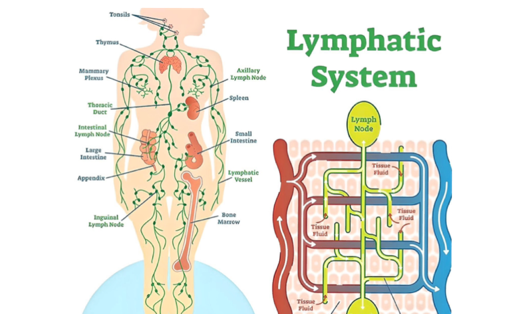Introduction
The lymphatic system is one of the most underappreciated yet vital systems in the human body. It plays a crucial role in maintaining fluid balance, removing waste, and supporting the immune system. However, factors like poor lifestyle habits, stress, and illness can lead to lymphatic stagnation, causing swelling, fatigue, and a weakened immune response. In this post, we’ll explore what the lymphatic system is, what causes stagnation, and how you can support its function for better health.
What is the Lymphatic System?
The lymphatic system is a network of tissues, vessels, and organs that work together to keep your body healthy. Here’s a breakdown of its key components:
- Lymph: A clear fluid that transports nutrients, oxygen, and waste products. It also carries white blood cells to fight infections, making it essential for immune function.
- Lymph Vessels: Tubes that circulate lymph throughout the body.
- Lymph Nodes: Small, bean-shaped structures that filter lymph and trap harmful substances like bacteria and viruses.
- Lymphatic Organs:
- Spleen: Filters blood and supports immunity.
- Thymus: Produces T-cells, a type of white blood cell.
- Tonsils and Adenoids: Protect against throat infections.
- Bone Marrow: Produces immune cells.
- Peyer’s Patches: Found in the intestines, they defend against harmful gut bacteria.
Together, these components maintain fluid balance, remove waste, and keep your immune system strong.
What Causes Lymphatic Stagnation?
When the lymphatic system becomes sluggish, it can lead to fluid retention, swelling, and a weakened immune response. Common causes include:
- Poor Movement: A sedentary lifestyle or prolonged sitting/standing can hinder lymph flow.
- Dehydration: Since lymph is mostly water, inadequate hydration can thicken it, slowing circulation.
- Unhealthy Diet: Processed foods, high salt, and sugar can impair lymphatic function.
- Tight Clothing: Restrictive garments like tight bras or belts can block lymph flow.
- Stress: Chronic stress increases inflammation, negatively impacting lymphatic health.
- Toxin Overload: Exposure to environmental toxins or poor detoxification can overwhelm the system.
- Infections or Illness: Viral, bacterial, or fungal infections can slow lymph movement.
- Surgery or Injury: Scar tissue or trauma can damage lymphatic vessels.
- Chronic Inflammation: Conditions like lymphedema or autoimmune diseases can disrupt lymphatic function.
Tips to Stimulate Lymphatic Flow
Keeping your lymphatic system healthy doesn’t have to be complicated. Here are 13 simple yet effective ways to support lymph flow:
- Movement and Exercise:
- Walking, rebounding (jumping on a mini-trampoline), stretching, or yoga can all stimulate lymph flow.
- Hydration:
- Drink plenty of water and include herbal teas like dandelion or ginger for added detox support.
- Dry Brushing:
- Use a natural-bristle brush to gently stroke your skin toward your heart before showering.
- Self-Massage:
- Use light, rhythmic strokes in the direction of lymph flow, focusing on areas with lymph nodes (neck, armpits, groin).
- Deep Breathing:
- Practice diaphragmatic breathing to create pressure changes that move lymph fluid.
- Lymphatic Drainage Therapy:
- Consider professional manual lymphatic drainage (MLD) for targeted stimulation.
- Healthy Diet:
- Incorporate anti-inflammatory foods like leafy greens, berries, and nuts, and limit processed foods and sugar.
- Cold and Contrast Showers:
- Alternate between hot and cold water to stimulate circulation.
- Wear Loose Clothing:
- Avoid tight-fitting clothes that restrict lymph flow.
- Inversions:
- Elevate your legs or try yoga poses like “Legs-Up-the-Wall” to encourage drainage.
- Infrared Sauna or Epsom Salt Baths:
- Use gentle heat to promote sweating and detoxification.
- Avoid Toxins:
- Reduce exposure to alcohol, tobacco, and environmental toxins.
- Stay Active:
- Avoid prolonged sitting or standing; move regularly throughout the day.
Conclusion
Your lymphatic system is a powerhouse of health and healing, but it needs care and attention to function optimally. By incorporating simple practices like movement, hydration, self-massage, and a healthy diet, you can support your lymphatic system, reduce swelling, and boost your immune response. Start small, stay consistent, and watch how your body thanks you for the extra care!
Call to Action
Have you tried any of these tips to support your lymphatic system? Share your experiences or questions in the comments below! If you found this post helpful, don’t forget to share it with friends and family who might benefit from a healthier lymphatic system. Let’s spread the word about this incredible system and its role in our well-being!
References:
- Olga Shishova, MD, Russian Federation : https://olgashishova.ru/sotrudniki/shishova-olga-ivanovna/
- Stanislav Chernonog, School of Vector massage and Somatics, Moscow, Body sculpting massage (lymphatic massage/lymph drainage/body sculpting) 2024.
- Bruno Chikly, MD, DO. Silent Waves: Theory and Practice of Lymph Drainage Therapy, 2nd ed. (Scottsdale: I.H.H. Publishing, 2004).
Nadejda Chouljenko

